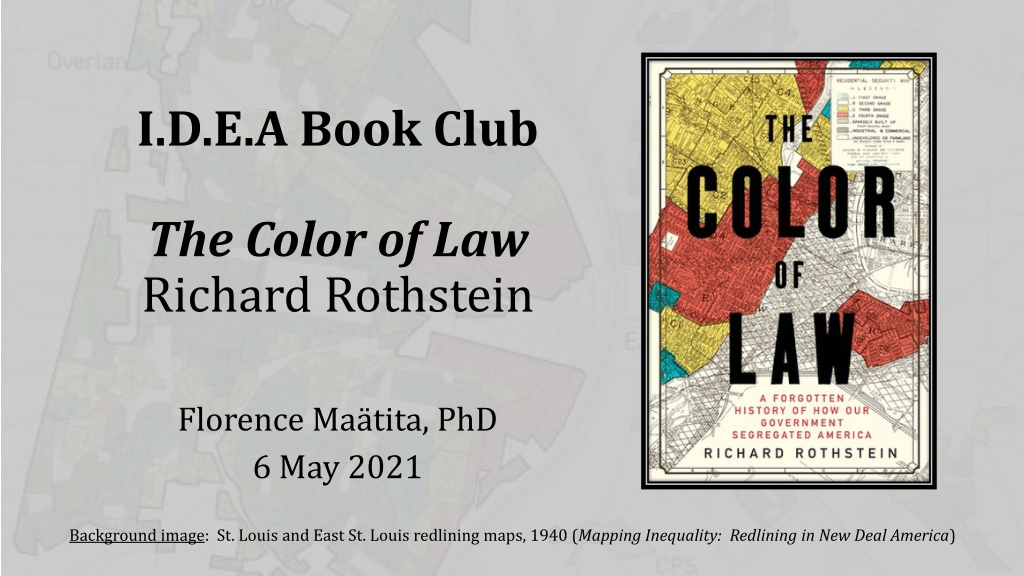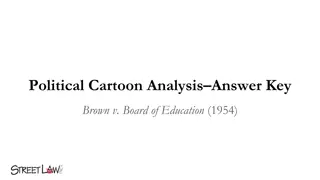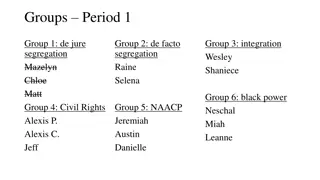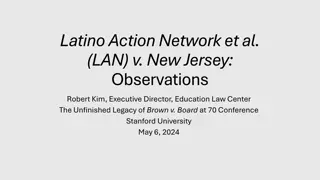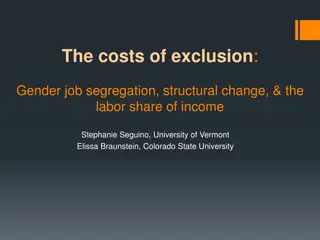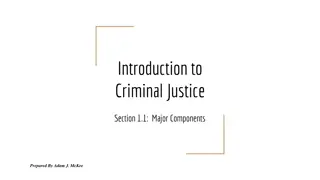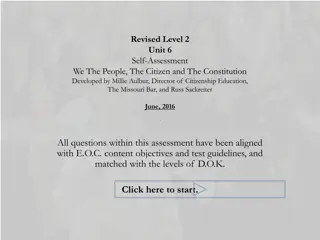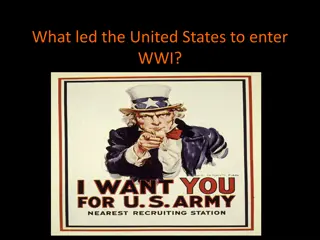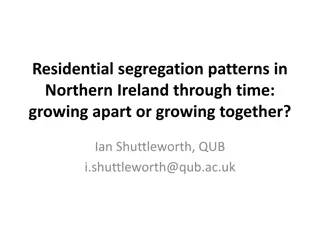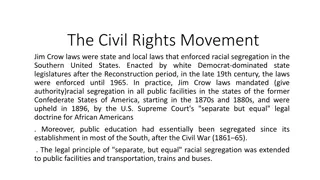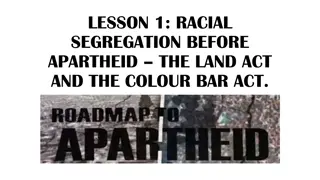Understanding Residential Segregation in the United States
Residential segregation in the US is a complex issue rooted in historical patterns of discrimination and inequality. It is perpetuated by factors such as white flight, redlining, and lack of capital. Measures of segregation, such as the segregation index, highlight persistent disparities in housing patterns among racial groups. Landmark sociological works emphasize the impact of segregation on urban poverty and racial inequality. Addressing these issues requires a multifaceted approach that considers employment, education, law enforcement, health, and social services.
- Residential Segregation
- Housing Discrimination
- Racial Inequality
- Urban Poverty
- Historical Discrimination
Download Presentation

Please find below an Image/Link to download the presentation.
The content on the website is provided AS IS for your information and personal use only. It may not be sold, licensed, or shared on other websites without obtaining consent from the author. Download presentation by click this link. If you encounter any issues during the download, it is possible that the publisher has removed the file from their server.
E N D
Presentation Transcript
I.D.E.A Book Club The Color of Law Richard Rothstein Florence Ma tita, PhD 6 May 2021 Background image: St. Louis and East St. Louis redlining maps, 1940 (Mapping Inequality: Redlining in New Deal America)
Narratives in The Color of Law Residential segregation is a product of our private choices. The There is a perfect place for everyone to live. opportunity structure is open to everyone. Racism was a Southern enterprise. Home The way to end racial discrimination is to end racial discrimination. ownership is central to the American Dream. America is the land of the free. 2
What is Residential Segregation? The language of segregation: Slum Ghetto Inner city (never an outer city) Urban blight Nice neighborhood Safe neighborhood Black or White neighborhood First residential Single family v. multi-family Concentration of different groups (race-ethnicity; religion; social class; immigrant status) in separate neighborhoods Racial segregation is measured by the degree to which racial groups are distributed throughout a city Question: Is there another way to measure either degrees of segregation or integration? (integrated block method) 3
Segregation Index in the 50 Largest US Metros (2016) Using these Census data, we see that the upward slope indicates the historical origins of racial segregation. Cities with the highest levels of residential segregation in 2016 (including St. Louis and Chicago) are the same ones that had established patterns of residential segregation in 1970, and have experienced marginal population growth. St. Louis, MO 1970 pop as a share of 2016 pop = 90% Black segregation index .72 4
Place Matters * Issues that Rothstein addressed Employment* Environment* Schools* Law Access to wealth* enforcement* Residential Segregation Health Social services Housing costs* Food security Transportation* 5
Landmark Sociological Work on Residential Segregation To Farley et al. (1978), residential segregation is not a matter of the economic status of Blacks or Blacks preferences to live near one another. Rather, it s ultimately about whites resistance to residential integration. To Massey and Denton (1998), residential segregation has the greatest effect on the perpetuation of urban poverty and racial inequality. 6
Narrative 1. Residential segregation is a product of our private choices. The causes of residential segregation include: White flight Steering Redlining Lack of capital to move to the suburbs Birds of a feather Class snobbishness Societal discrimination (Chief Justice John Roberts, 2007) De facto segregation The causes of residential also include: Policies at the federal, state and local levels defined and dictated who should live where State and federal agencies (e.g., Federal Hosing Administration; churches; universities) that upheld and enforced said policies State and federal entities (Internal Revenue Service) that endorsed the agencies that upheld said policies De jure segregation 7
(1) From a Series on the Negro Community in The Edwardsville Intelligencer (Sept 1964) About Arthur L. Grant, a Negro community consultant for Southern Illinois University : [Real estate agents] said Grandview was not ready for a Negro (9/21/64, p. 2) C.C. Jones, the principal at Lincoln School said that Negroes in the know are for open occupancy. Negroes do not necessarily want to move, he explained. They just want the freedom to move where they desire (9/21/64, p. 5) The Roxana and Wood River pools have rules that allow only citizens living in the respective taxing districts to use the facilities Since few, if any, Negroes live in Roxana and Wood River, pool authorities know any Negro is not entitled to enjoy the water Whether there is prejudice behind the situation is almost impossible to prove (9/23/64, p. 2). Colored people are deeply sensitive to not being wanted in numerous places and often will pass by a park, restaurant or church because they are afraid they will start trouble or be embarrassed. As a result, Negroes tend to be clannish (9/23/64, p. 5). 8
(1) Map of Edwardsville (1964) (1) Includes Klein Ave, Highland St, Wynona St (2) Negro district on West Union St (4) Off Marine Rd east of town (3) Largest segregated spot includes Chestnut St, Pine St, Olive St (5) Acknowledged slum on Isherwood Ave (6) Integrated housing along Schwartz St 9
(1) Justifying Segregation Key factors for making your property values increase: Real estate factors: supply and demand; comparable sales Economic factors: job markets; population growth; cost of borrowing Location: school district; zoning regulations; new commercial businesses; access to the city center The home: usable square footage; property age/condition; renovations/updates; curb appeal Ordinarily, the negro loves to gather to himself, for he is very gregarious and sociable in his nature. But those who have risen somewhat above their fellows appear to have an intense desire to leave them behind, to disown them, as it were, and get as close to the company of white people as circumstances will permit them. [Milton Dashiel, lawyer who drafted ordinance to prevent African Americans from buying homes on white blocks in Baltimore (Rothstein 2017: 44; citing Power (1983) and Pietila (2010))] There go the property values! ( There goes the neighborhood! ) 10
(1) Race Relations and Equality in Edwardsville, December 2020 DISCRIMINATION IN HOUSING Note: Our community should look at the particular housing history of our area. There have been innumerable regulations, policies and actions many overtly racist, some with hidden racist intent, and some simply with racist outcomes, all which have created the general de facto segregation in the Metro East. Our city needs to review and revise all regulations which impact housing discrimination. Consider further investigation and data collection regarding possible patterns of housing discrimination in the City. [ ] Find ways to promote and encourage reporting of housing discrimination to proper authorities 11
(1) What Rothstein Says Our private choices about where to live (assuming we have a choice) play a role in contributing to residential segregation The more important issue, to Rothstein, is the role of the government federal, state and local and their policies in generating such segregation Moreover, Rothstein asserts that there would be some degree of segregation in U.S. cities, but it might be less severe with a lack of support and legitimation from the government 12
Narrative 2. Racism was a Southern enterprise. Agricultural economy reigned in the Southern U.S., and slavery was the primary issue leading up to the Civil War Constitutional Amendments in the aftermath of the Civil War Industrialization in the US boomed after the Civil War Business activity was centered in urban centers Regional differences: Industry grew primarily in the North Frontier life was coming to an end in the West The South lagged as it continued to rely on agriculture 13
(2) The Great Migration (2 Waves) First wave (1915-1940) ~1.6 million African Americans St. Louis, MO; Chicago, IL; Philadelphia, PA; Detroit, MI; NYC/Long Island, NY; Boston, MA Second wave (1940-1970) ~3.4 million African Americans Los Angeles, CA; San Francisco/Oakland, CA; Denver, CO; Kansas City, MO; Seattle, WA; Portland, OR 14
(2) Whites Responses to (Potential) Changes in African Americans Status White flight (1950s -), exurbanization Sundown towns James Loewen (2005): most outside of the South; 507 throughout Illinois Sundown Towns in the US (East Alton; Glen Carbon; Granite City; Highland; Madison; Maryville; Roxana; Wood River) Outright/state sanctioned violence and terror Lynching throughout the US (reported) Race riots (69 race riots between 1865 and 1945) Lynching was more prevalent in the South than in other geographic regions Segregation ordinances Restrictive covenants (1920s-1968) New Deal (1933-1939) Federal Housing Administration (1934-present) 15
(2) What Rothstein Says As Rothstein illustrates, racism was not merely a Southern enterprise. Rather, systemic racism (especially in the form of residential segregation) is evident throughout the U.S. Most of the cities he focuses on were major terminal points for either wave of the Great Migration (e.g., Chicago, Detroit, St. Louis, San Francisco) Was? Implies that racism is a thing of the past in the South, the North, the Midwest, the West Economic interests are national interests: preserve slavery to protect the southern economy; push for segregation to protect property values 16
Narrative 3. America is the land of the free. It says so in The Star-Spangled Banner Francis Scott Key, an anti-abolitionist, wrote the song during the War of 1812 What is freedom? Control over how we are governed Peaceful enjoyment and private independence (Benjamin Constant) Matter of degree of power between government and populace Philosophical and political distinctions between freedom, liberty and democracy Regardless of what you think it means to be free, do we all have equal access and entitlements to privacy, peace and control? 17
(3) 5th Amendment (1791) Nutshell: The government cannot treat citizens unfairly No person shall be held to answer for a capital, or otherwise infamous crime, unless on a presentment or indictment of a grand jury, except in cases arising in the land or naval forces, or in the militia, when in actual service in time of war or public danger; nor shall any person be subject for the same offense to be twice put in jeopardy of life or limb; nor shall be compelled in any criminal case to be a witness against himself, nor be deprived of life, liberty, or property, without due process of law; nor shall private property be taken for public use, without just compensation. Eminent domain 18
(3) 13th Amendment (1865) End of chattel slavery except as punishment Section 1. Neither slavery nor involuntary servitude, except as a punishment for crime whereof the party shall have been duly convicted, shall exist within the United States, or any place subject to their jurisdiction. Section 2. Congress shall have power to enforce this article by appropriate legislation. Congress can enforce this ban by passing appropriate legislation Congress to pass laws to eradicate the badges and incidents of slavery 19
(3) 14th Amendment (1868) Citizenship Clause: Should all state laws be applied to citizens? What are the legal benefits to citizenship? Section 1. All persons born or naturalized in the United States, and subject to the jurisdiction thereof, are citizens of the United States and of the state wherein they reside . No state shall make or enforce any law which shall abridge the privileges or immunities of citizens of the United States ; nor shall any state deprive any person of life, liberty, or property, without due process of law; nor deny to any person within its jurisdiction the equal protection of the laws. [ ] Privileges and Immunities Clause: Related to state citizenship or national citizenship? Equal Protection Clause: Read into the 5th Amendment to prevent the federal govt from discriminating 20
(3) 15th Amendment (1870) Did not give African American men the right to vote. Section 1. The right of citizens of the United States to vote shall not be denied or abridged by the United States or by any state on account of race, color, or previous condition of servitude. Section 2. The Congress shall have power to enforce this article by appropriate legislation. 21
(3) Illinois The Free State 1720 Slavery allowed in Northwest Territory (inc Illinois) 1787 Prohibited slavery in the NW Territory 1809 Creation of Illinois territory; Ninian Edwards becomes territorial governor 1813 Legislation preventing free Blacks from moving to Illinois territory 1818 Illinois gains statehood; Edwardsville is incorporated 1819 Legislation to limit the rights of free people of color in Illinois 1874 Legislation requiring public schools to admit Black students 1877 Lincoln School (elementary) opens in Edwardsville 1950-1951 First African American students enroll at Edwardsville High Edwardsville and Collinsville school boards paid for African American high school students to attend Lincoln HS (East St. Louis), Sumner HS (St. Louis) or Lincoln University HS (Jefferson City) 22
(3) What Rothstein Says [This court feels there is] no more reprehensible un-American activity than to attempt to deprive persons of their own homes on a master race theory. -Los Angeles Superior Court Judge Stanley Mosk on a case regarding covenants in 1947 (cited in Rothstein 2017: 104). Rothstein questions what it means to have a constitutional obligation to protect and ensure rights for citizens By demonstrating the role that (1) federal, state and local governments have played in creating/enforcing segregation policies, (2) state and federal agencies have played in upholding and enforcing said policies, and (3) that state and federal entities played in endorsing the agencies that upheld said policies, Rothstein indicates that we have done a great disservice and injustice by abandoning that obligation Who is really free? 23
Fixing the Narratives Who suffers when we ignore our constitutional obligation to protect and ensure everyone s rights as citizens? Proposed fixes: Policies to promote integration and inclusion Ban zoning ordinances and replace them with inclusionary ordinances National Fair Share Act (John Charles Boger, 1993): create new market incentives to support integrative housing choices and provide market disincentives to discourage segregative choices Community improvements Cannot forget about other social institutions such as education, law enforcement, healthcare, workplace 24
THANK YOU Now it s time for your questions 25
